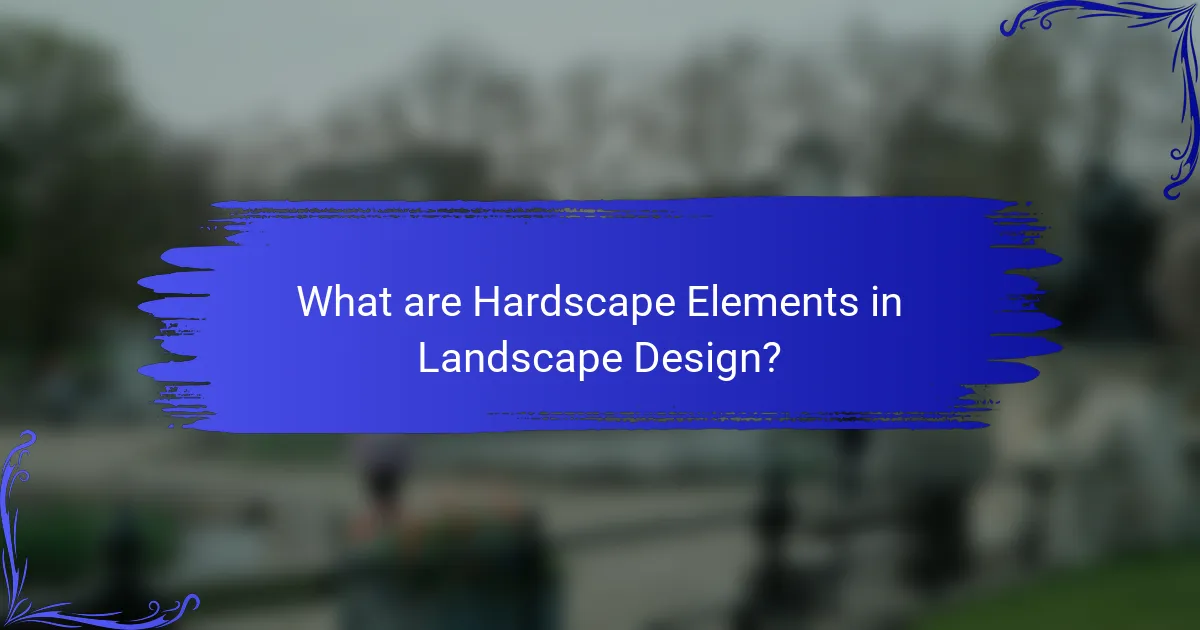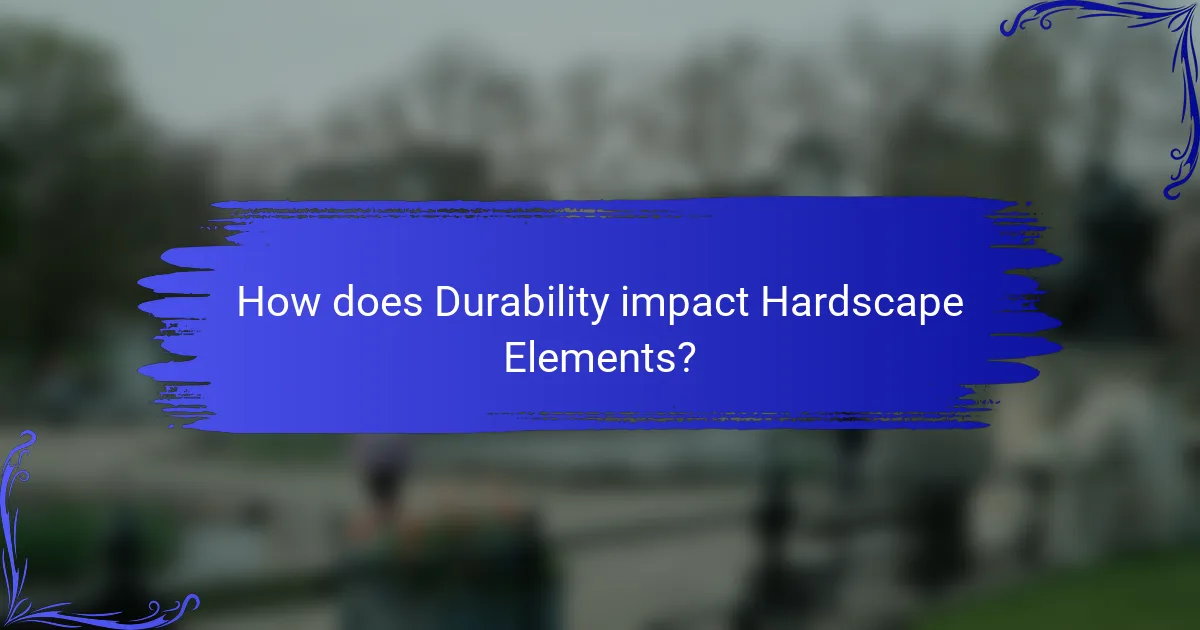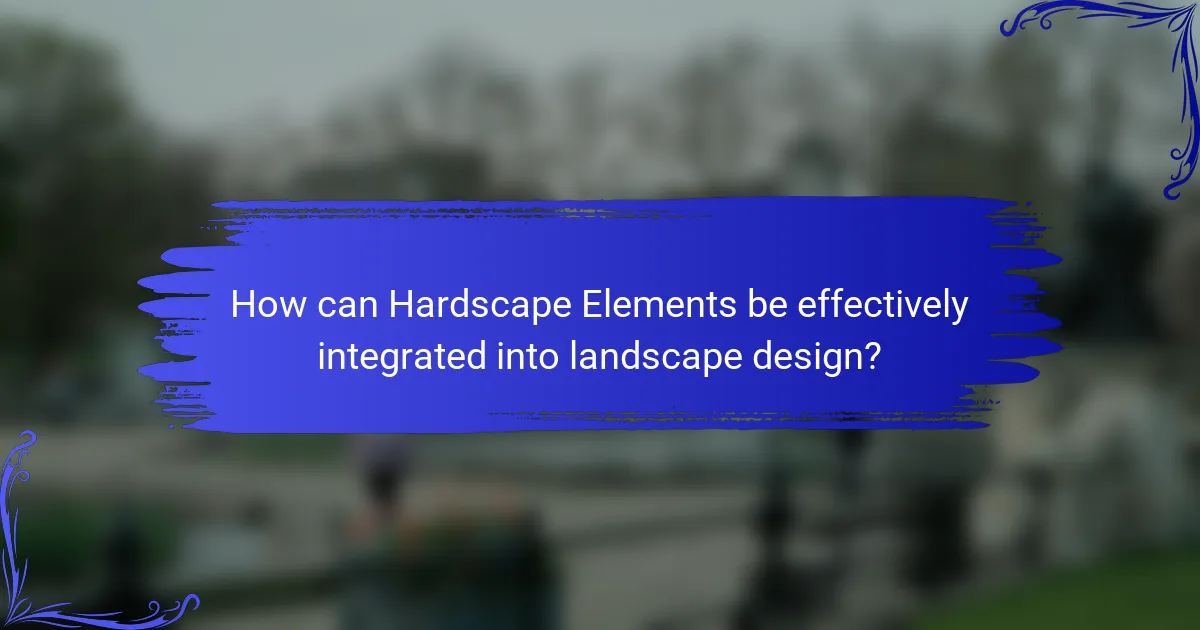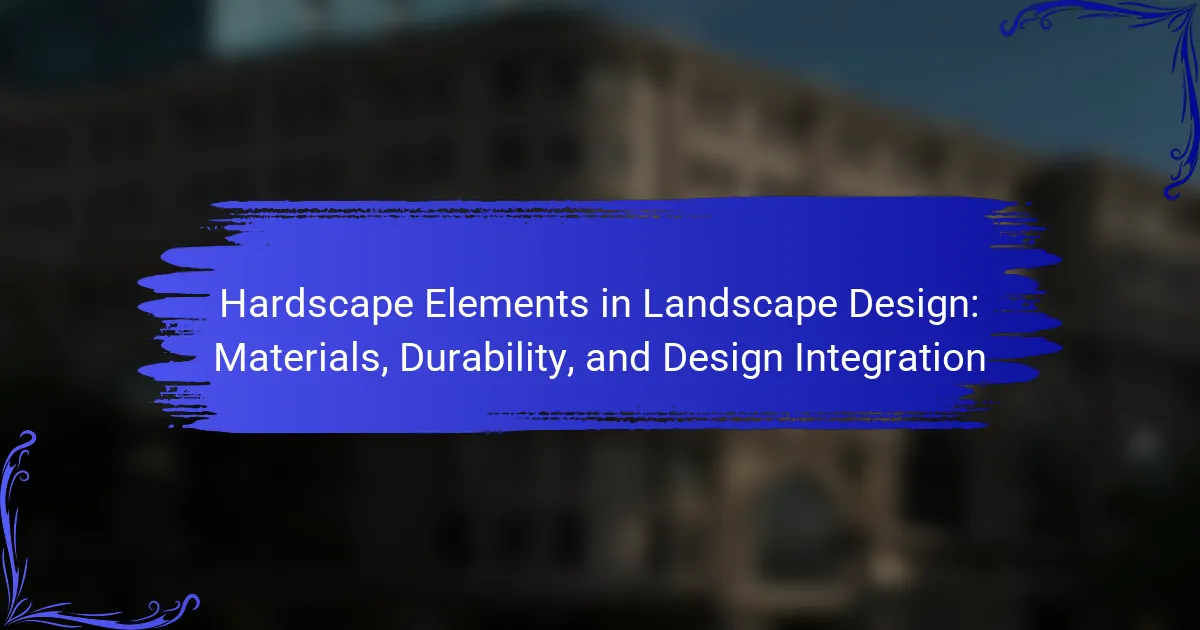Hardscape elements in landscape design encompass the non-plant components, including materials such as stone, concrete, wood, and metal. These elements serve both functional purposes, like pathways and patios, and enhance the aesthetic appeal of outdoor spaces. The article examines the durability of hardscape materials, highlighting their longevity and reduced maintenance needs, which contribute to cost savings and increased property value. Additionally, it discusses the importance of integrating hardscape features with the natural environment while considering design aspects like scale, proportion, and drainage. Finally, the article emphasizes the role of plantings in softening hardscape appearances and promoting biodiversity.

What are Hardscape Elements in Landscape Design?
Hardscape elements in landscape design refer to the non-plant components of a landscape. These include materials such as stone, concrete, wood, and metal. Hardscape elements serve functional purposes, like pathways, patios, and retaining walls. They also enhance the aesthetic appeal of outdoor spaces. The integration of hardscape elements can define areas and create structure within a landscape. Their durability often surpasses that of softscape elements, providing long-lasting solutions. Properly designed hardscape can improve drainage and reduce erosion. Overall, hardscape elements play a crucial role in landscape functionality and design.
How do Hardscape Elements differ from Softscape Elements?
Hardscape elements are non-living components in landscape design, while softscape elements are living components. Hardscape includes materials like stone, brick, and concrete. These materials provide structure and durability to outdoor spaces. Softscape, on the other hand, consists of plants, trees, and soil. Softscape elements contribute to the aesthetic and ecological balance of a landscape. Hardscape elements require minimal maintenance compared to softscape elements, which need regular care and watering. Additionally, hardscape can enhance functionality, such as creating walkways and patios. Overall, the primary difference lies in the living versus non-living nature of these elements.
What are the key characteristics of Hardscape Elements?
Hardscape elements are non-plant features in landscape design. They include materials like stone, concrete, and wood. Durability is a key characteristic, ensuring longevity and low maintenance. Hardscape elements provide structure and functionality to outdoor spaces. They influence drainage and soil erosion management. Aesthetic appeal is also important, enhancing visual interest. Versatility allows for various designs and applications. Integration with softscape elements creates harmony in landscapes.
Why are Hardscape Elements important in landscape design?
Hardscape elements are crucial in landscape design because they provide structure and functionality. They include materials like stone, brick, and concrete. These elements define spaces and create pathways. Hardscapes help manage water drainage and reduce soil erosion. They enhance the aesthetic appeal of outdoor areas. Research shows that well-designed hardscapes can increase property value by up to 15%. Furthermore, they require less maintenance compared to softscape elements. This durability makes them a practical choice for long-term landscape planning.
What materials are commonly used for Hardscape Elements?
Common materials used for hardscape elements include concrete, natural stone, brick, and pavers. Concrete is versatile and can be molded into various shapes. Natural stone offers durability and aesthetic appeal. Brick provides a classic look and is known for its strength. Pavers come in different materials and designs, allowing for creative patterns. These materials are chosen for their longevity, low maintenance, and ability to withstand weather conditions.
What are the advantages of using stone in hardscaping?
Stone in hardscaping offers durability, aesthetic appeal, and low maintenance. Its natural resistance to weathering ensures longevity in outdoor environments. Stone can withstand heavy loads and resist cracking, making it suitable for driveways and patios. The variety of colors and textures enhances landscape design, allowing for creative expression. Additionally, stone does not require painting or sealing, reducing upkeep costs. According to the National Association of Home Builders, stone products can increase property value due to their timeless appeal.
How does concrete compare to other hardscape materials?
Concrete is a durable hardscape material that offers advantages over alternatives like pavers and natural stone. It is typically more cost-effective than natural stone, making it a popular choice for large projects. Concrete can also be molded into various shapes and finishes, allowing for versatile design options. In terms of maintenance, concrete requires less upkeep than pavers, which may shift over time. Additionally, concrete has a longer lifespan, often exceeding 30 years with proper care. Its ability to withstand harsh weather conditions further enhances its appeal compared to other materials. These factors contribute to concrete’s widespread use in landscape design.

How does Durability impact Hardscape Elements?
Durability significantly impacts hardscape elements by determining their lifespan and maintenance needs. Durable materials withstand weather, wear, and tear more effectively. This reduces the frequency of repairs and replacements. For example, concrete and stone are known for their longevity. They resist cracking and erosion better than softer materials. As a result, durable hardscape elements contribute to cost savings over time. Studies show that investing in durable hardscape can enhance property value. This is due to their aesthetic appeal and functional reliability.
What factors influence the durability of Hardscape Elements?
The durability of hardscape elements is influenced by material selection, environmental conditions, installation quality, and maintenance practices. Material selection determines resistance to weathering and wear. For example, concrete and stone offer high durability, while wood may degrade faster. Environmental conditions include exposure to moisture, temperature fluctuations, and UV radiation, which can affect lifespan. Proper installation ensures structural integrity and reduces the risk of damage. Maintenance practices, such as sealing and cleaning, can enhance durability by preventing deterioration. Studies show that well-maintained hardscape elements can last significantly longer than those neglected.
How do climate and environmental conditions affect durability?
Climate and environmental conditions significantly affect the durability of hardscape materials. Factors such as temperature fluctuations, moisture levels, and exposure to UV radiation can lead to material degradation. For instance, freeze-thaw cycles can cause cracking in concrete and stone. High humidity can promote mold and mildew growth, weakening materials over time. Additionally, UV exposure can lead to fading and brittleness in plastics and composites. A study by the National Institute of Standards and Technology found that materials exposed to harsh climates had a reduced lifespan compared to those in milder conditions. Thus, understanding these environmental impacts is crucial for selecting durable materials in landscape design.
What maintenance practices can enhance the longevity of Hardscape Elements?
Regular cleaning of hardscape elements prevents the buildup of dirt and debris. This practice reduces staining and maintains appearance. Sealing surfaces is essential to protect against moisture and weather damage. Sealing should occur every few years, depending on the material. Inspecting for cracks or damage allows for timely repairs. Early intervention prevents further deterioration. Proper drainage management is crucial to avoid water pooling. Water pooling can cause erosion and structural damage over time. Regular maintenance enhances the durability and lifespan of hardscape elements significantly.
Why is it essential to consider durability in design integration?
Durability is essential in design integration because it ensures the longevity and functionality of hardscape elements. Durable materials withstand environmental stressors such as weather, wear, and tear. This leads to reduced maintenance costs over time. Studies show that durable designs can last significantly longer, often exceeding 20 years. For example, concrete pavers are known for their durability and can endure heavy foot traffic and harsh weather. Incorporating durability into design also enhances aesthetic appeal, as well-maintained elements contribute positively to the overall landscape. Therefore, considering durability is crucial for sustainable and cost-effective landscape design.
How does durability affect the overall aesthetics of a landscape?
Durability significantly enhances the overall aesthetics of a landscape. Durable materials maintain their appearance over time, resisting wear and tear. This longevity ensures that the landscape remains visually appealing without frequent maintenance. For instance, stone and concrete are known for their durability and can withstand various weather conditions. In contrast, less durable materials may fade or deteriorate, negatively impacting the visual cohesion of the landscape. A well-maintained durable landscape can create a sense of permanence and stability. Research shows that landscapes featuring durable hardscape elements often have higher property values. Thus, the aesthetic appeal is directly linked to the choice of durable materials in landscape design.
What role does durability play in cost-effectiveness over time?
Durability significantly enhances cost-effectiveness over time. Durable materials require less frequent replacement and maintenance. This reduces long-term expenses associated with repairs and replacements. For example, concrete can last over 30 years with minimal upkeep. In contrast, less durable materials may need replacement every few years. Therefore, investing in durable hardscape elements can lead to substantial savings. Studies show that durable landscaping materials can save homeowners up to 50% in maintenance costs over a decade. Thus, durability plays a crucial role in maximizing the value of landscape investments.

How can Hardscape Elements be effectively integrated into landscape design?
Hardscape elements can be effectively integrated into landscape design by ensuring they complement the natural environment. This integration begins with selecting materials that match the surrounding landscape. For example, using local stone can create a cohesive look.
Incorporating hardscape features like patios, walkways, and retaining walls enhances functionality. These elements can define spaces and provide structure to the landscape.
Design considerations should include scale and proportion. Large hardscape elements may overwhelm smaller gardens, while smaller features can get lost in expansive areas.
Additionally, the placement of hardscape elements should consider drainage and erosion control. Properly designed hardscapes can direct water flow and reduce maintenance needs.
Finally, integrating plantings around hardscape features softens their appearance. Using native plants can enhance biodiversity and create a harmonious blend between hardscape and softscape.
What are the best practices for integrating Hardscape Elements?
Best practices for integrating hardscape elements include planning for functionality and aesthetics. Start by assessing the landscape’s natural features. Consider the flow of foot traffic and how hardscape will complement existing plants. Use materials that match the overall design theme. Ensure proper drainage to prevent water pooling. Incorporate durable materials that withstand weather conditions. Utilize contrasting textures to enhance visual interest. Lastly, maintain a balance between hardscape and softscape for a cohesive look. These practices ensure that hardscape elements enhance the landscape’s usability and beauty.
How can color and texture be used to enhance integration?
Color and texture can enhance integration in landscape design by creating visual harmony and depth. Color influences mood and perception, making spaces feel cohesive. For example, using complementary colors can tie different hardscape elements together. Texture adds dimension, making surfaces visually interesting. Rough textures can contrast with smooth ones, highlighting features. This contrast can guide movement and draw attention to focal points. Research shows that well-integrated colors and textures improve user experience in outdoor spaces. A study by Kaplan and Kaplan in “Environmental Psychology” emphasizes the importance of aesthetic coherence in landscape design.
What design principles should be followed for cohesive integration?
Cohesive integration in landscape design requires adherence to several key design principles. First, consistency in materials is essential. Using similar textures and colors enhances visual harmony. Second, scale and proportion should be considered. Elements must relate well to each other and the surrounding environment. Third, balance is crucial. Symmetrical and asymmetrical arrangements can create a pleasing aesthetic. Fourth, continuity in lines and shapes promotes flow throughout the space. Fifth, functionality must align with aesthetics. Each hardscape element should serve a purpose while contributing to overall design. Lastly, consider the context of the environment. Integrating natural surroundings into the design fosters a cohesive look. These principles are supported by landscape architecture guidelines, emphasizing the importance of unity in design.
What are common challenges in Hardscape integration?
Common challenges in hardscape integration include achieving proper drainage and ensuring structural stability. Poor drainage can lead to water pooling, which damages both hardscape and surrounding vegetation. Structural stability issues may arise from improperly installed materials, leading to cracks or shifts over time. Additionally, integrating hardscape with existing landscape elements can create aesthetic mismatches. This often requires careful planning to ensure a cohesive design. Soil erosion can also be a challenge, particularly in sloped areas, necessitating the use of retaining walls or other solutions. Lastly, maintenance can be demanding, as hardscape materials may require periodic cleaning and repair to maintain their appearance and functionality.
How can designers overcome issues related to site drainage?
Designers can overcome issues related to site drainage by implementing effective grading techniques. Proper grading directs water away from structures and prevents pooling. Designers should also incorporate drainage systems, such as French drains or swales, to facilitate water movement. These systems can effectively manage excess water flow and reduce erosion. Additionally, using permeable materials for hardscape elements allows water to infiltrate the ground. This approach minimizes runoff and enhances groundwater recharge. Regular maintenance of drainage systems ensures they function properly over time. By applying these strategies, designers can create sustainable landscapes that effectively manage drainage issues.
What strategies can be used to blend Hardscape with Softscape elements?
To blend Hardscape with Softscape elements, use complementary materials and design techniques. Select colors and textures that harmonize both elements. For instance, match stone pavers with natural stone in softscape features. Incorporate curves in hardscape to mimic the organic shapes found in plants. Use planters, raised beds, or walls to create transitions between hardscape and softscape. Integrate pathways that guide through softscape areas, enhancing flow and accessibility. Water features can serve as focal points that bridge both elements. Finally, consider seasonal changes in plants to maintain visual interest alongside permanent hardscape features. These strategies create a cohesive and balanced landscape design.
What practical tips can improve the design and functionality of Hardscape Elements?
Use a variety of materials to enhance visual interest in hardscape elements. Combining stone, brick, and concrete can create a dynamic look. Ensure proper drainage to prevent water accumulation around hardscape features. This helps maintain the integrity of the materials and prevents erosion. Incorporate functional elements like seating walls or raised beds. These features add usability while enhancing aesthetics. Consider the scale and proportion of hardscape elements to the surrounding landscape. This ensures harmony and balance in design. Use permeable materials in walkways to improve water absorption. This helps reduce runoff and supports local ecosystems. Plan for maintenance by selecting durable materials that withstand weather conditions. This extends the lifespan and functionality of hardscape elements.
Hardscape elements in landscape design encompass non-plant components such as stone, concrete, wood, and metal, which provide structure, functionality, and aesthetic appeal to outdoor spaces. This article explores the characteristics, materials, and advantages of hardscape elements, emphasizing their durability and low maintenance compared to softscape elements. It also addresses the importance of integrating hardscape with softscape for cohesive design, while discussing best practices for effective implementation, drainage solutions, and strategies to enhance visual harmony. Key factors influencing durability and maintenance practices are examined to highlight their impact on landscape longevity and cost-effectiveness.
